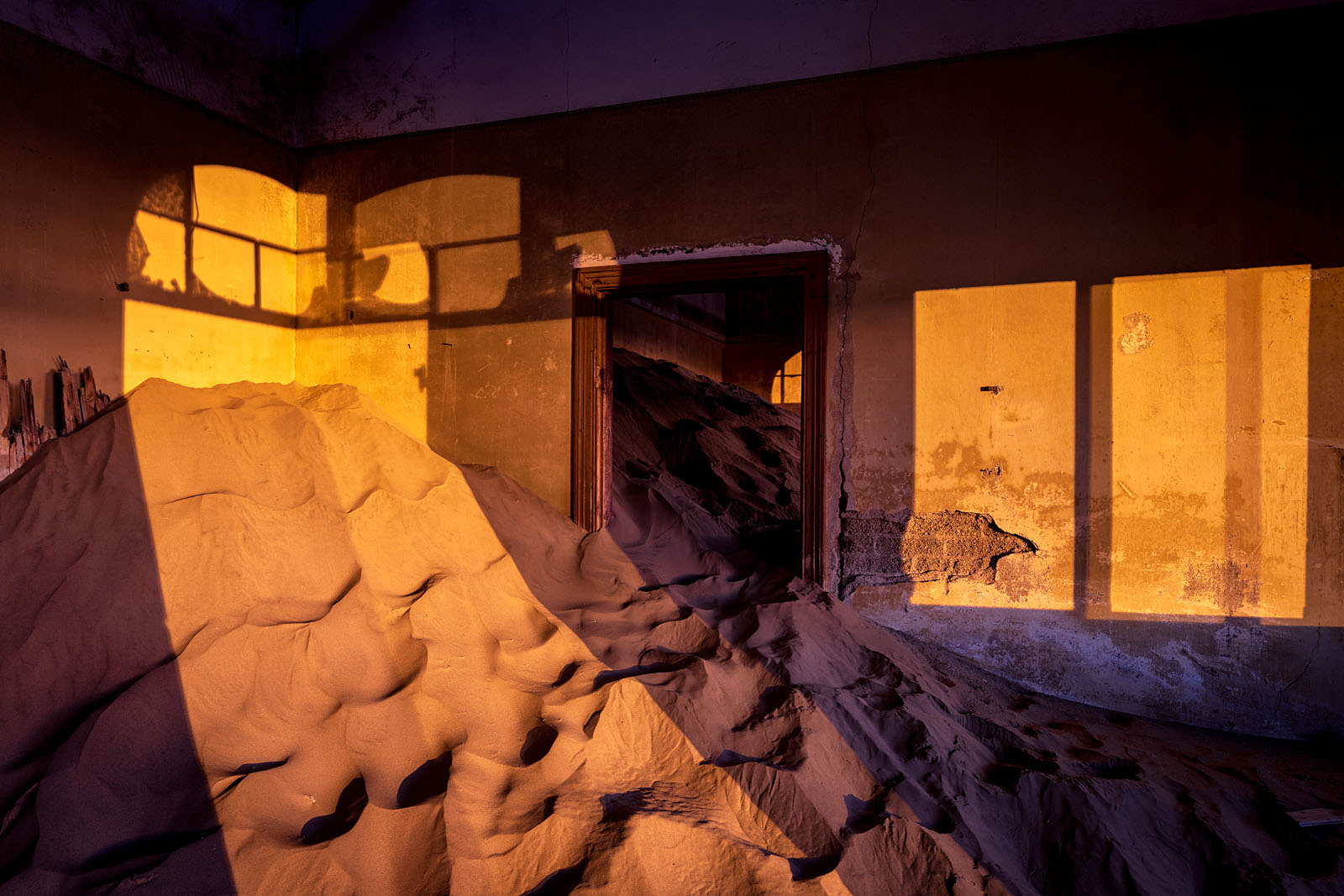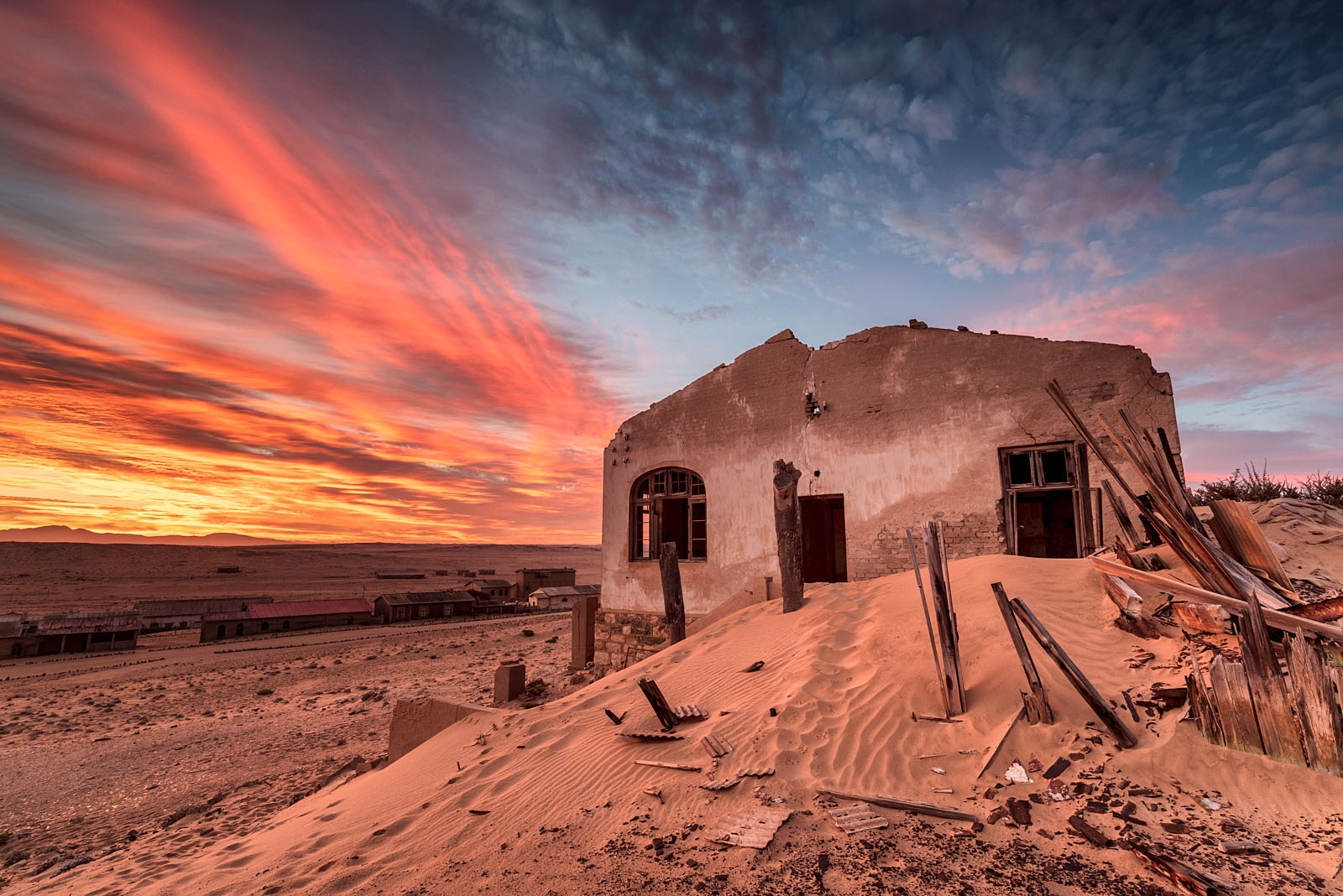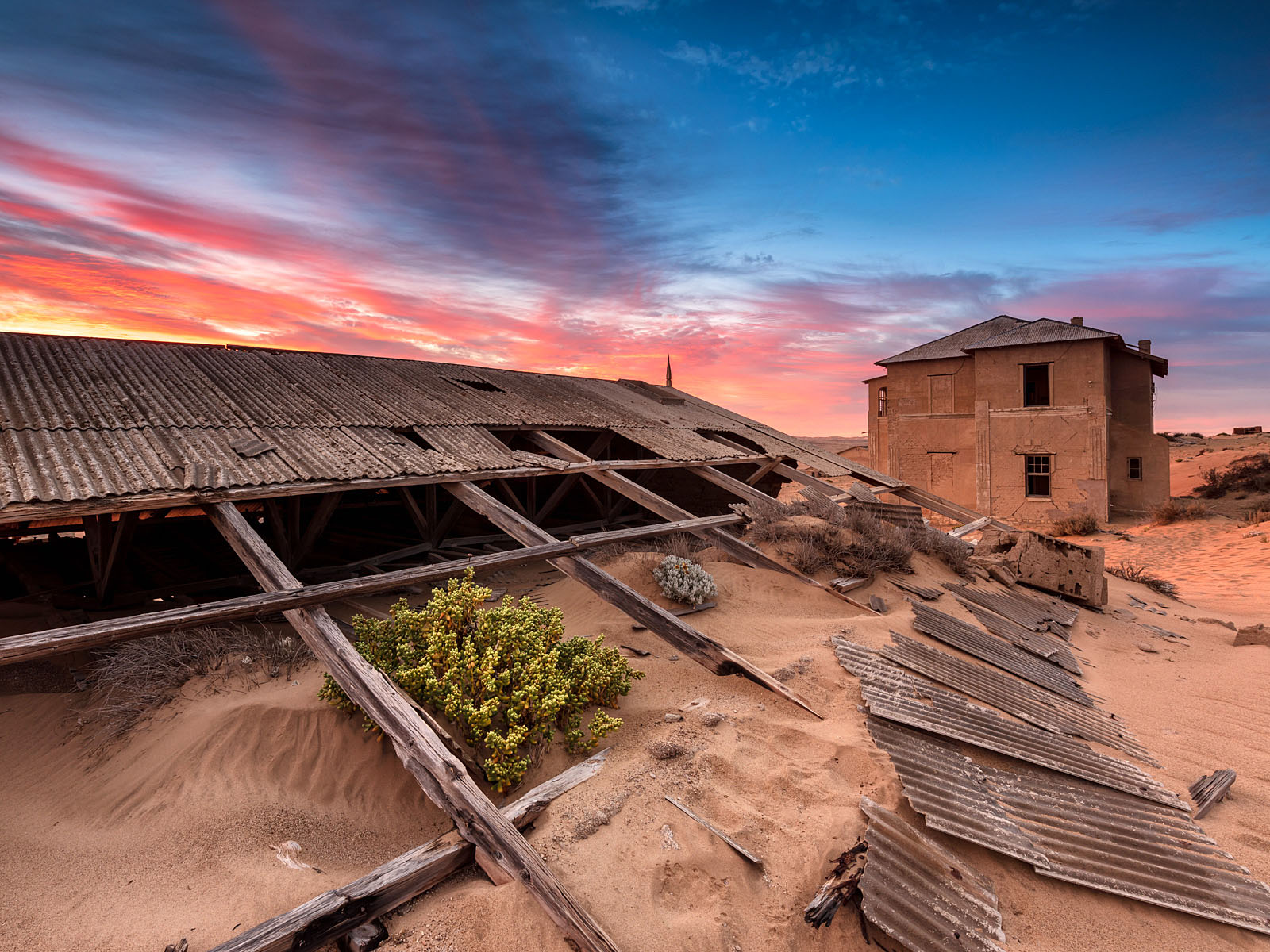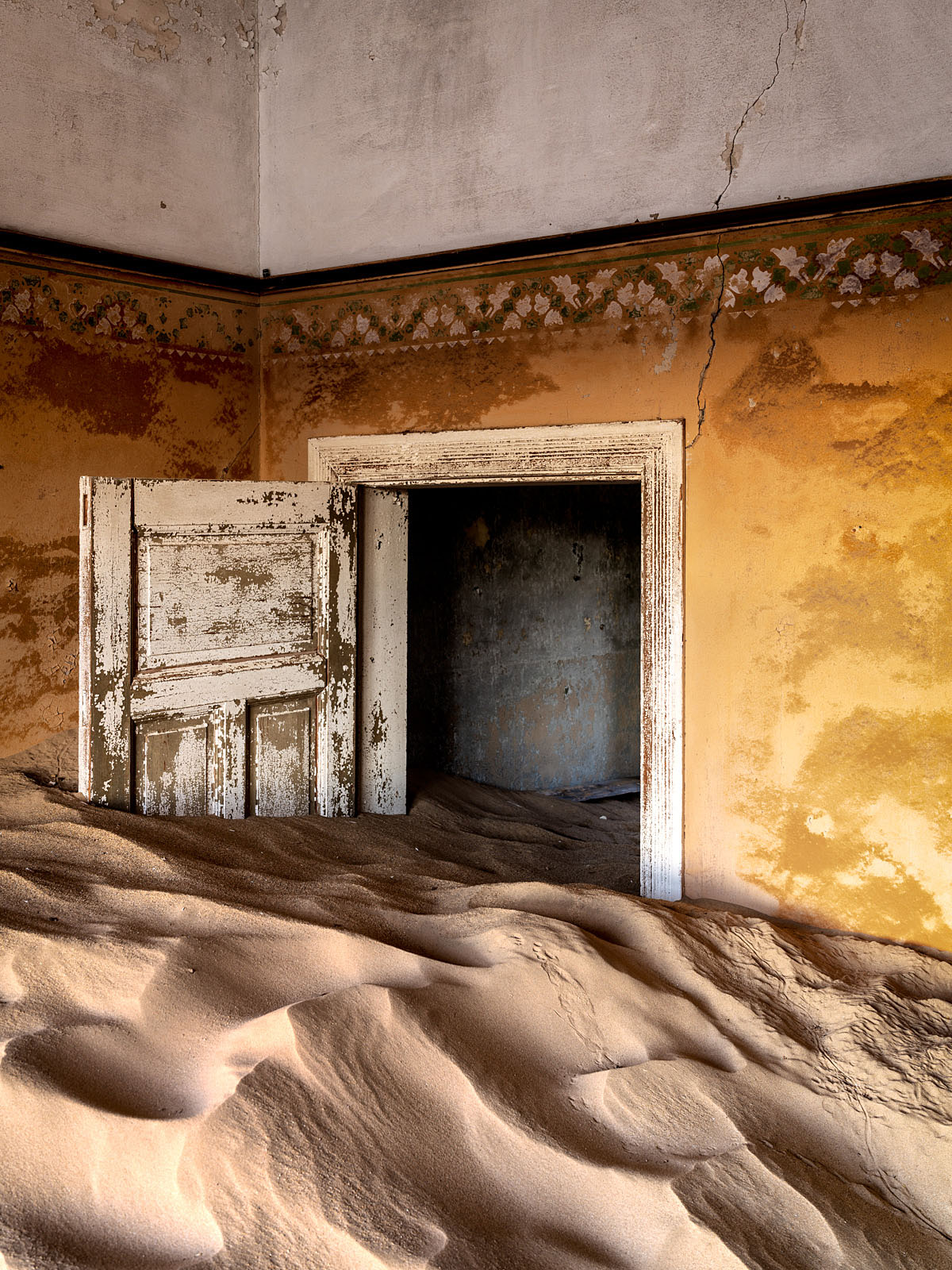Refer to the bottom of this post for a warning about a possible health risk for this site that you should be aware of if you choose to visit.
In southern Namibia near the small mining and fishing port of Luderitz is a truly unique and interesting location for photography. Surrounded by an apocalyptic looking barren landscape, Kolmanskop Ghost Town is unlike any other location that I have been too. Like many other locations in Namibia this is one of those places that has been on my wish list for some time and one of the reasons I decided to return to Namibia.
Kolmanskop is a long deserted diamond mining settlement that is slowly being swallowed up by dunes and disintegrated by the harsh weather. I suspect that the deterioration is not as quick as it might have been in a an environment with more moisture and regular rains. The mining operation dates back to when Namibia was still under German colonial rule, starting in the first decade of the 20th century and finally petering out in the 1950’s. The settlement was built in a German style and is a mixture of commercial buildings, worker’s barracks and elegant management residences – some still with German nameplates on the front like ‘Architekt’.
The photographic appeal of this unusual place is the dichotomy of the architecture and the decay, the rooms filled with sand, the doors propped open by dunes. The fact that the settlement is surrounded by a forbidding and arid landscape just makes the scene more stark. Yet there is beauty to be found inside with the peeling but colourful paint on the walls and wind rippled sand that has built up in many of the rooms.
Pentax K1, 15-30 @ 15mm, ISO 100, f16, 2.5 sec
Pentax 645z, 28-45 @ 28mm, ISO 100, f8, 30 sec
Access to this site is quite easy. It is only 15 minutes drive from Luderitz (where I recommend staying in the comfortable Luderitz Nest Hotel). Tours are run daily but to get access for sunrise and sunset shoots you need to have a photography permit purchased in advance. Once you leave this on the dashboard of your vehicle you can access the small side gate at the entry check point (vehicle access will be closed off at these hours) and walk into the site. On all four sesions that I visited I had the place completely to myself.
On the first couple of sessions I focused on exploring the interiors. I found that the doors seemed to be the most appealing. It was difficult finding area’s of sand that didn’t have footprints and mostly I just had to live with them. You really do need to explore every building to find all the hidden away little gems. Many of the rooms are blocked off from the inside and you have to climb through a window. Others will require you to scramble through internal doors that are about half as high as they used to be because of the level of the sand that has blown in.
Pentax K1, 15-30 @ 15mm, ISO 100, f16, 2.5 sec
Pentax K1, 15-30 @ 15mm, ISO 100, f18, 5.0 sec
One of the considerations that you should make when composing images is to follow the general architectural photography principle of keeping your verticals vertical, something that is even more important when using ultra-wide angle lenses that can have a very distorting effect on the perspectives. You can do this mostly by just keeping the camera level on the tripod. Where this isn’t possible remember to frame your composition with extra space around it to allow for the cropping that will result when you correct the perspectives in Lightroom during your post processing. If you have a tilt-shift lens it would be very handy here.
Pentax 645z, 28-45 @ 32mm, ISO 100, f11, 8 sec
Pentax K1, 15-30 @ 15mm, ISO 100, f16, 1.6 sec
On the later couple of sessions I tried shooting exteriors. My last evening the sky was cloudless (usually death for landscape images) but lit up in pink which resulted in some unexpectedly nice backdrops. The management residences higher up the hill are worth exploring. The below shot shows how engulfed one of the buildings is - the sand dune is up to roof level. In their hey-day these homes would have been beautiful, even opulent but now they have a sort of faded elegance.
Pentax 645z, 28-45 @ 28mm, ISO 100, f16, 1.0 sec
Pentax 645z, 28-45 @ 28mm, ISO 100, f16, 1.6 sec
On my last morning as I headed out of town I changed my plan of heading straight past because the skies all of a sudden were cloudy and dramatic. I have not seen many images online of Kolmanskop exteriors so the chance to get some really unique images with decrepit buildings and amazing skies was wonderful. A dramatic sky really can make even the most unusual of settings like this really come to life.
Pentax K1, 15-30 @ 15mm, ISO 100, f16, 0.5 sec
Pentax K1, 15-30 @ 15mm, ISO 100, f16, 2.0 sec
All in all this was a fantastic place to photograph and well worth the time and expense involved getting there. It is a location that is not as weather dependent as most landscape locations so whatever the skies are doing you should be able to get great shots of the interiors. The nearby lighthouse, the surrounding dunes and desert coastline a comfortable hotel and lovely Namibian people all make Kolmanskop and Luderitz an interesting and enjoyable place to visit.
Pentax K1, 15-30 @ 21mm, ISO 100, f16, 2.5 sec
Pentax K1, 15-30 @ 15mm, ISO 100, f16, 2.5 sec
Pentax 645z, 28-45 @ 28mm, ISO 100, f9.0, 3.0 sec
Pentax 645z, 28-45 @ 43mm, ISO 100, f9.0, 3.0 sec
Pentax 645z, 28-45 @ 45mm, ISO 100, f8.0, 0.6 sec
A Note of Caution: I discovered while I was walking around that some of the buildings had what I am almost certain is asbestos roof sheeting. You can see some in a couple of the images above. I don’t know for sure it if is asbestos but it seems most likely. Because I visited the site outside the normal visitors hours and did not attend any of the organised tours I don’t know if this is something the operators warn about. The asbestos sheeting is in places scattered around on the ground in small pieces and it seems like there is at least a possibility that on a windy day there could be the chance of breathing in asbestos fibres whipped up by the wind. I did not let this risk deter me (there wasn’t much wind at the time luckily) but it is something you should take into account if you are interested in visiting. Maybe coming prepare with a face mask wouldn’t be a bad idea.














